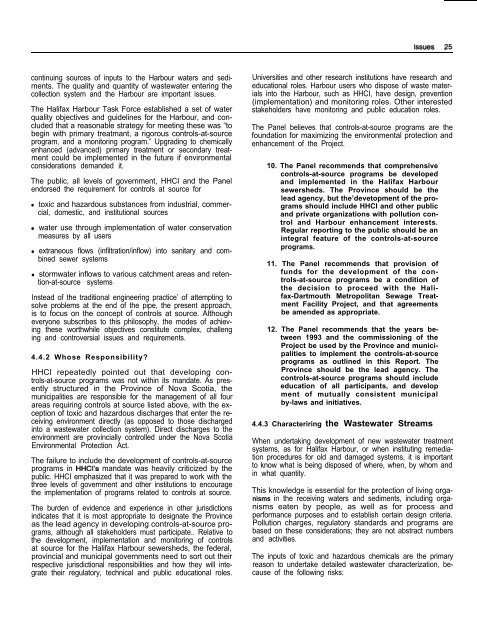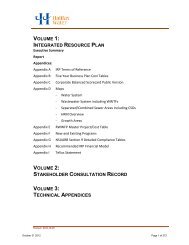Halifax Harbour Cleanup Inc. - Halifax Regional Municipality
Halifax Harbour Cleanup Inc. - Halifax Regional Municipality
Halifax Harbour Cleanup Inc. - Halifax Regional Municipality
You also want an ePaper? Increase the reach of your titles
YUMPU automatically turns print PDFs into web optimized ePapers that Google loves.
continuing sources of inputs to the <strong>Harbour</strong> waters and sediments.<br />
The quality and quantity of wastewater entering the<br />
collection system and the <strong>Harbour</strong> are important issues.<br />
The <strong>Halifax</strong> <strong>Harbour</strong> Task Force established a set of water<br />
quality objectives and guidelines for the <strong>Harbour</strong>, and concluded<br />
that a reasonable strategy for meeting these was “to<br />
begin with primary treatmant, a rigorous controls-at-source<br />
program, and a monitoring program.” Upgrading to chemically<br />
enhanced (advanced) primary treatment or secondary treatment<br />
could be implemented in the future if environmental<br />
considerations demanded it.<br />
The public, all levels of government, HHCI and the Panel<br />
endorsed the requirement for controls at source for<br />
• toxic and hazardous substances from industrial, commercial,<br />
domestic, and institutional sources<br />
• water use through implementation of water conservation<br />
measures by all users<br />
• extraneous flows (infiltration/inflow) into sanitary and combined<br />
sewer systems<br />
• stormwater inflows to various catchment areas and retention-at-source<br />
systems<br />
Instead of the traditional engineering practice’ of attempting to<br />
solve problems at the end of the pipe, the present approach,<br />
is to focus on the concept of controls at source. Although<br />
everyone subscribes to this philosophy, the modes of achieving<br />
these worthwhile objectives constitute complex, challeng<br />
ing and controversial issues and requirements.<br />
4.4.2 Whose Responsibility?<br />
HHCI repeatedly pointed out that developing controls-at-source<br />
programs was not within its mandate. As presently<br />
structured in the Province of Nova Scotia, the<br />
municipalities are responsible for the management of all four<br />
areas requiring controls at source listed above, with the exception<br />
of toxic and hazardous discharges that enter the receiving<br />
environment directly (as opposed to those discharged<br />
into a wastewater collection system). Direct discharges to the<br />
environment are provincially controlled under the Nova Scotia<br />
Environmental Protection Act.<br />
The failure to include the development of controls-at-source<br />
programs in HHCl’s mandate was heavily criticized by the<br />
public. HHCI emphasized that it was prepared to work with the<br />
three levels of government and other institutions to encourage<br />
the implementation of programs related to controls at source.<br />
The burden of evidence and experience in other jurisdictions<br />
indicates that it is most appropriate to designate the Province<br />
as the lead agency in developing controls-at-source programs,<br />
although all stakeholders must participate.. Relative to<br />
the development, implementation and monitoring of controls<br />
at source for the <strong>Halifax</strong> <strong>Harbour</strong> sewersheds, the federal,<br />
provincial and municipal governments need to sort out their<br />
respective jurisdictional responsibilities and how they will integrate<br />
their regulatory, technical and public educational roles.<br />
Universities and other research institutions have research and<br />
educational roles. <strong>Harbour</strong> users who dispose of waste materials<br />
into the <strong>Harbour</strong>, such as HHCI, have design, prevention<br />
(implementation) and monitoring roles. Other interested<br />
stakeholders have monitoring and public education roles.<br />
The Panel believes that controls-at-source programs are the<br />
foundation for maximizing the environmental protection and<br />
enhancement of the Project.<br />
10. The Panel recommends that comprehensive<br />
controls-at-source programs be developed<br />
and implemented in the <strong>Halifax</strong> <strong>Harbour</strong><br />
sewersheds. The Province should be the<br />
lead agency, but the’devetopment of the programs<br />
should include HHCI and other public<br />
and private organizations with pollution control<br />
and <strong>Harbour</strong> enhancement interests.<br />
Regular reporting to the public should be an<br />
integral feature of the controls-at-source<br />
programs.<br />
11. The Panel recommends that provision of<br />
funds for the development of the controls-at-source<br />
programs be a condition of<br />
the decision to proceed with the <strong>Halifax</strong>-Dartmouth<br />
Metropolitan Sewage Treatment<br />
Facility Project, and that agreements<br />
be amended as appropriate.<br />
12. The Panel recommends that the years between<br />
1993 and the commissioning of the<br />
Project be used by the Province and municipalities<br />
to implement the controls-at-source<br />
programs as outlined in this Report. The<br />
Province should be the lead agency. The<br />
controls-at-source programs should include<br />
education of all participants, and develop<br />
ment of mutually consistent municipal<br />
by-laws and initiatives.<br />
4.4.3 Characteriring the Wastewater Streams<br />
When undertaking development of new wastewater treatment<br />
systems, as for <strong>Halifax</strong> <strong>Harbour</strong>, or when instituting remediation<br />
procedures for old and damaged systems, it is important<br />
to know what is being disposed of where, when, by whom and<br />
in what quantity.<br />
This knowledge is essential for the protection of living organisms<br />
in the receiving waters and sediments, including organisms<br />
eaten by people, as well as for process and<br />
performance purposes and to establish certain design criteria.<br />
Pollution charges, regulatory standards and programs are<br />
based on these considerations; they are not abstract numbers<br />
and activities.<br />
The inputs of toxic and hazardous chemicals are the primary<br />
reason to undertake detailed wastewater characterization, because<br />
of the following risks:

















